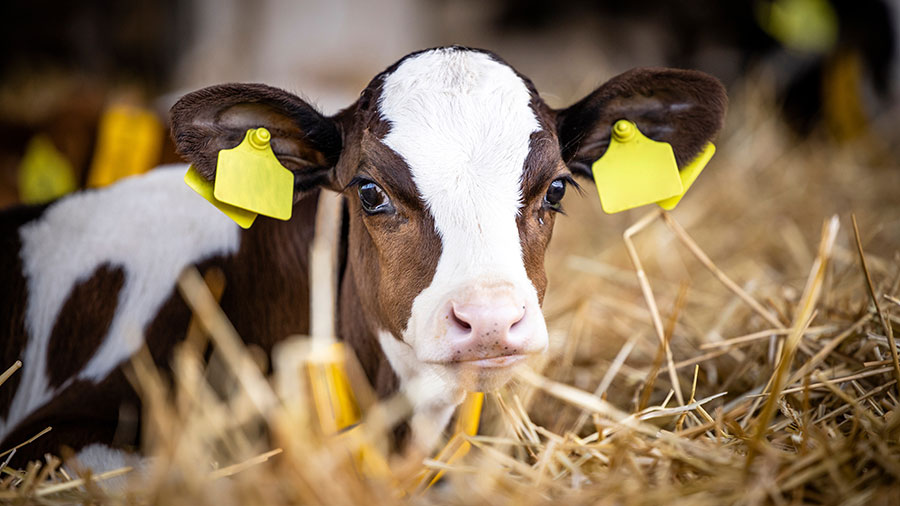9 tips on maximising calf health and minimising mortality
 © AdobeStock/littlewolf1989
© AdobeStock/littlewolf1989 Farmers should think of calf management in the same way as looking after a baby, ensuring they are provided with a dry, draught-free bedroom, warm living room and clean kitchen.
This is the advice of independent calf specialist Stuart Fry of the Complete Calf Consultancy.
See also: WIYLS visits a £225,000 calf shed modelled on broiler design
Stuart, and Alison Clark from Progiene Dairy Hygiene, suggest the following ways farmers can ensure calves are housed correctly and remain healthy:
- House calves of a similar age together (not more than seven days’ difference in birth date) to reduce the spread of disease. Ideally, no more than 30 calves should share the same air space.
- Ensure calf housing is well drained by providing a sloping floor with a gradient of 1:20.
- Ensure three sides of the pen are solid and at least 1.2m high to reduce the bacterial load. Research has shown this could reduce airborne bacteria by 20%.
- Provide enough space for the calf: 1sq m for the bedding area and 1.5sq m for the living and kitchen space, giving a total of 2.5sq m a calf.
- Make pens accessible so they can be easily cleaned out.
- Provide enough clean bedding (options include sawdust, peat, bark/mulch, straw, or a combination of these) and perform the “kneel test” to check it is dry for calves to lie down. (Kneel in the calf pen for 30 seconds to 1 minute. When you stand, your knees should still be dry. If not, provide more bedding or improve drainage.)
In addition, aim for pens to score 3 for nesting – this is where legs are generally not visible when lying down. A nesting score of 3 combined with three solid pen walls can make a massive difference to calf health. - Good ventilation is important for calf health: the dirtier the air, the greater the infectious pressure. And it is easier to warm up a shed than to cool it down. A shed should be designed to suit the calving system on the farm: for example, if block calving, the shed should be designed to be able to handle a lot of calves of the same age at once.
- Ensure good biosecurity measures are in place. Boot dipping is the first line of defence and should be placed at the entrances and exits to calf housing, milking parlour, cow accommodation and feed stores.
There should also be facilities to disinfect the wheels of any vehicles entering the farm. Keeping track of when the disinfectant needs changing, by using an audit sheet, is advisable.
Choice of disinfectant will depend on what you are trying to protect and where you are using it. Defra-approved disinfectants have approved efficacy for a disease you are trying to control. - Know what the disease pressures are on the farm and where they are coming from. If health problems arise, find out what the problem is, and in the case of scour, use a scour testing kit to identify the source and provide effective treatment.
See also: Advice on supportive care of scouring calves
If a calf gets a poor start, it will never reach its full potential.
Case study: Highbury Holsteins, County Tyrone
Hygiene is key to keeping calf mortality below 2% at Dr Amanda Dunn’s family farm in County Tyrone.
Amanda is the calf rearer on the farm, which runs a 130-head autumn block-calving Holstein herd.
She puts her calves’ good health partly down to housing them in an open-fronted shed in groups of six, following building alterations six years ago.
The farm takes a “regimental” approach to rearing youngstock.
Boots are washed and dipped on entry to the calf housing and disinfectant is renewed regularly.
Cows are milked immediately after giving birth, using a portable milker, and calves are licked dry and then transported to the calf house.
Every calf receives 4 litres of colostrum within one hour of birth and, at the next milking, is offered 2-3 litres via a teat bucket.
They are then fed transition milk for 12-14 days before moving on to a milk replacer from 15 days until five weeks. They are gradually weaned at between five and 10 weeks.
Simple system
“It’s a simple system,” says Amanda. “The feeder’s height is so important [so] calves are reaching up, opening their [oesophageal] grooves [to avoid the risk of ruminal bloat]. Consistency is key.”
All calves are individually penned using hurdles that are then removed after the first week of life.
This means they are housed from the start with the calves they will be grouped with, eliminating the stress of moving between pens.
Calves are kept warm with coats and heat lamps in extreme cold when needed.
Hygiene is essential in keeping calves healthy, with feeders washed after every feed and then dipped in acid. The youngest calves are also fed first.
Dry feed is offered from the start, and clean water is provided on a daily basis. “We also fill half-blue barrels with eating straws to discourage calves from eating off the floor,” she says.
“You’ve got to be good all round to keep calf mortality low,” she adds.
Stuart Fry, Alison Clark and Amanda Dunn were speaking at a Calf Chat webinar, organised by Bonanza Calf Nutrition.
